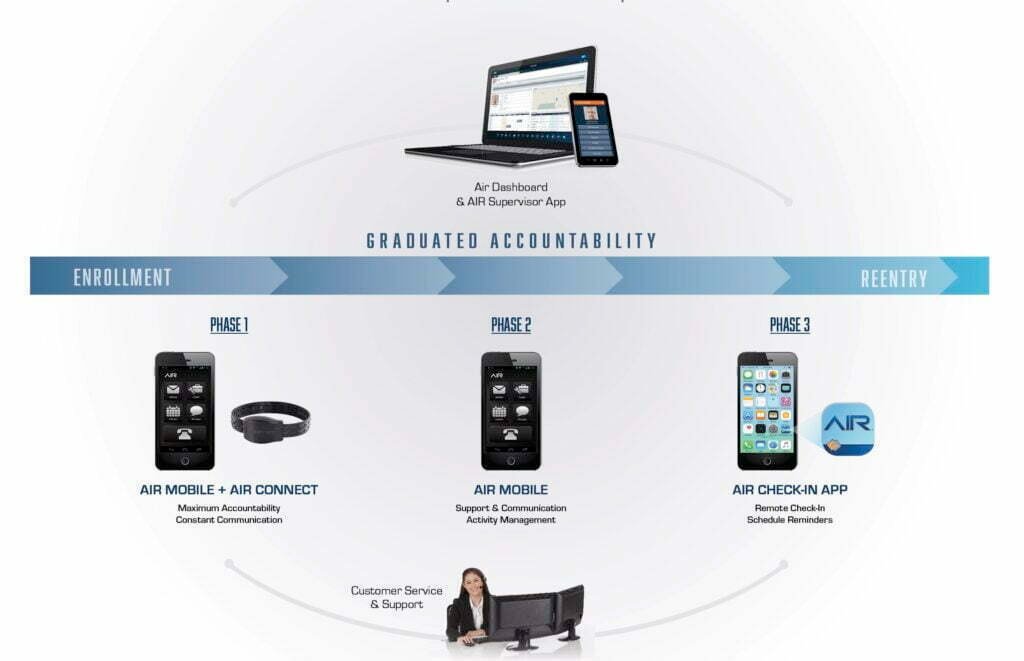Wearable “Solutions” and the Internet of Incarceration


Orinoco Tribune – News and opinion pieces about Venezuela and beyond
From Venezuela and made by Venezuelan Chavistas

By Jeremy Loffredo – May 20, 2021
A new push is underway to sell wearable devices and sensors as the solution to the opioid and prison crises in the US. However, this “solution” is set to come at a major cost to civil liberties and human freedom in general.
In recent years, calls for radical prison reform and a solution to the U.S.’ opioid crisis have come to permeate national politics in the United States. With over two million people behind bars and more than 400,000 people dead from opioid misuse in the last two decades, these topics are often on the front page of major newspapers in the U.S. and abroad.
However, at the same time, the marketing of wearable technology, or wearables, as a solution to both of these hot-button issues has become promoted by key players in both the public and private sectors. Especially since COVID-19, these electronic devices that can be worn as accessories, embedded in clothes or even implanted under the skin, are frequently heralded by corporations, academics and influential think tanks as “cost effective”, technological solutions to these deeply rooted problems.
Yet, as will be covered in this article, the shift towards wearables may offer more costs than benefits, particularly when it comes to matters of civil liberties and privacy.
The World Economic Forum and Wearables

On paper, the World Economic Forum (WEF, also known as the International Organization for Public Private Cooperation) is an NGO and think tank “committed to improving the state of the world.” In reality, it’s an international network of some of the wealthiest and most powerful people on Earth. The organization is best known for its annual gathering of the (mostly white, European and North American) ruling class. Each year hedge fund managers, bankers, CEOs, media representatives and heads of state gather in Davos to “shape global, regional and industry agendas.” As Foreign Affairs once put it, “the WEF has no formal authority, but it has become a major forum for elites to discuss policy ideas and priorities.”
In 2017, WEF Founder Klaus Schwab put out a book called “The Fourth Industrial Revolution.” The WEF uses the term Fourth Industrial Revolution (4IR) to denote the current “technological revolution” that is changing the way people “live, work, and relate to one another,” and with implications “unlike anything humankind has experienced before.” The 4IR is characterized by new technologies like artificial intelligence (AI), robotics, 3D printing, and the “internet of things,” which essentially denotes embedding things with sensors – including human bodies in the form of wearables.
Like the industrial ‘revolutions’ that came before, the main theme for the WEF’s Fourth Industrial Revolution is that it will allow companies to produce more, more quickly and for far less money.
In the book, Schwab positions wearable technology as key to helping companies become organized around remote work by providing one’s employers “with a continuous exchange of data and insights about the things or tasks being worked on.” In a similar vein, Schwab emphasizes the “wealth of information that can be gathered from wearable devices and implantable technologies.”
But unlike the industrial ‘revolutions’ of the past, the WEF’s 4IR aims to blur the distinction between the physical, digital, and biological spheres. And the WEF is a vocal advocate for wearables in their propensity to propel what it calls ‘human enhancement.’
In 2018, Schwab teamed up with WEF’s “Head of Society and Innovation” Nicholas Davisto write a follow up book entitled “Shaping the Future of the Fourth Industrial Revolution.”Having been with the organization for over a decade, Davis was the obvious choice to co-author this book as he now “lead[s] the theme of the Fourth Industrial Revolution” at the WEF.
Schwab and Davis see wearables as just a stepping stone for the 4IR, writing that wearable devices “will almost certainly become implantable” in the body and the brain. “External wearable devices, such as smart watches, intelligent earbuds and augmented reality glasses, are giving way to active implantable microchips that break the skin barrier of our bodies, creating intriguing possibilities that range from integrated treatment systems to opportunities for human enhancement,” they write.
The authors note the potential to “drive an industry of human enhancement” that would, in turn, enhance “worker productivity.” However, other groups, including those partnered with the WEF, see other potential applications for their use well beyond the workplace.
Wearables, the Opioid Crisis and the War on Drugs
Deloitte, the world’s largest accounting firm and a longstanding partner of the WEF, has promoted wearables as a way to resolve the opioid epidemic. In 2016, Deloitte’s Center for Government Insights put out a report outlining how to fight the opioid crisis. The authors make the case that “technologists” and “innovators” should be part of the solution to the opioid crisis. Then, in 2018, the firm put out an article called “Strategies For Stemming The Opioid Epidemic,” explaining how data analytics could be used to help pharmacy benefit managers chart their course.

Other WEF partners are more directly involved in this effort. For example, WEF ‘Global Shaper’ Ryan O’Shea is the co-founder of Behaivior, a company that says it’s creating “technology to predict and prevent addiction relapses” using wearables. O’Shea, in addition to his WEF ties, is also the social media manager for Humanity Plus, formerly the World Transhumanist Association, which received $100,000 from Jeffrey Epstein in 2018 in addition to previous donations from Epstein-linked charities. Epstein also donated significant sums to Humanity Plus’ chair, Ben Goertzel.
According to the Behaivior website, the company’s mission is described as follows:
“We are creating software that can take real-time data streams from wearable devices that detect heart rate, heart rate variability, skin temperature, motion, and galvanic skin response (which is related to stress levels). This data is combined with other digital information about behavior, such as GPS location. As behavior and physiology changes, our software screens users for whether or not they are in a pre-relapse craving state.”
The company markets itself as a solution for governments who want to cut down on costs. “Reducing addiction relapses not only saves lives, but it also saves significant amounts of money by reducing re-arrests, re-incarcerations,” the Behaivior site reads. According to government records, Behaivior has received $533,000 from the NIH since its founding. It also receives support from the National Institute on Drug Abuse and the National Science Foundation. Tellingly, the company describes their focus on opioid abuse as the company’s “initial use case,” implying that the technology may soon be applied to other illicit substances. In a section on their website entitled “Market Opportunities”, the company mentions the number of Americans “addicted to drugs and alcohol” and implies it could be used for any sort of substance addiction that people seek treatment for, including substances that are currently legal to purchase and consume.

Last year, the NIH also gave another company, Emitech, $328,000 to make a “forearm bracelet for rapid, on-site opioid intake monitoring and alerting.” On their website, Emitech states that “our major target users will be law enforcement units”, but adds that they could be used at other facilities such as “drug treatment centers” and “anywhere drug tests are required.”
Not unlike the private companies they are funding, the federal government is also moving money towards wearables being used to detect other criminalized substances as well as ones that are legal in some or all states. The NIH has granted money to a few wearablealcohol sensors as well as a wearable cocaine sensor. Additionally, it’s made a grant available for “the research and development of digital markers for detection of acute marijuana intoxication.”
That the WEF network sees wearables as key to stemming the opioid epidemic is particularly significant given that the Biden admin has signalled that it will focus heavily on this crisis once the COVID-19 crisis subsides.
“The bottom line for the Biden administration is that the [opioid] crisis is going to come into full awareness once covid starts moving into the background, perhaps in the first half of 2021,” the Washington Post quoted a professor saying in December 2020.
From Private Prisons to Wearable Prisons
In a much related manner, the ruling class also seems to be marrying the issue of mass incarceration with the wearables revolution.
“In a digital world with ankle bracelets and GPS devices, there is no reason to believe that physical imprisonment is the only option for those convicted of nonviolent offenses,” Darrell West wrote for the Brookings Institute in 2015. “Compared to incarceration, ankle bracelets and GPS devices seem far more tolerable. They keep offenders in society, are less punitive than prisons, and are much less expensive.”
West frames this digital incarceration as a desirable alternative where governments can cut costs but continue imprisoning the same amount of people as they do now. “Unless we find alternatives to physical imprisonment, the social and economic costs of jails will continue to sky-rocket,” he writes.

In 2013, the WEF-partnered Deloitte published an article on what it calls “virtual incarceration.” It envisions an automated monitoring system where parole officers can track people’s locations and an automated system sends “notifications to them when they have impending appointments, if they enter high-crime zones, or if their movements indicate that they are becoming more likely to commit a crime.”
The article also sees the use of this system as extending past the prison industry:
“ … Existing applications can already estimate blood alcohol content nearly as accurately as a breathalyzer—and predict the onset of depression. In the near future, contact with peer support groups, push notifications from case managers, and access to employers and other networks could be available at the touch of a button.”
A 2017 Australian Broadcasting Corporation article introduced something called the Technological Incarceration Project (TIP), a venture created by law professor Dan Hunter. The TIP proposes a form of “home detention” using “electronic sensors that monitor convicted offenders on a 24-hour basis.” This system, which Australian Broadcast Corporation calls an “internet of incarceration,” is meant to replace wardens and physical prisons, instead using advanced AI and machine learning to detect if a crime is about to be committed – and ensure that it doesn’t.
“Offenders would be fitted with an electronic bracelet or anklet capable of delivering an incapacitating shock if an algorithm detects that a new crime or violation is about to be committed,” it explains.
In 2018, Hunter co-wrote an article in the Journal of Criminal Law and Criminologyproposing this system as a “major revolution to the prison sector,” arguing that it would “result in the closure of nearly all prisons in the United States” and “end the prison crisis.” According to Swinburne University of Technology, where he is dean, Hunter’s work has been supported by theU.S. Government’s National Science Foundation.
The key to his revolution is an ankle bracelet with GPS tracking and an embedded conducted energy device, to administer the electric shock and incapacitate prisoners until the arrival of the police.
The article outlines the plan for technological incarceration in three components:
“First, offenders would be required to wear electronic ankle bracelets that monitor their location and ensure they do not move outside of the geographical areas to which they would be confined. Second, prisoners would be compelled to wear sensors so that unlawful or suspicious activity could be monitored remotely by computers. Third, conducted energy devices would be used remotely to immobilize prisoners who attempt to escape their areas of confinement or commit other crimes.”
Hunter and his co-authors argue that remote monitoring through wearable sensors is a superior alternative to traditional surveillance cameras. “ … Our proposal requires prisoners to wear a series of remote sensors—including those for sound, video, and movement—that are connected to central computer systems that can detect unauthorized behavior,” they write.
Hunter and his co-authors further insist that the third step, the “remote immobilization of offenders,” would actually make this technological incarceration more secure than a conventional prison, since there is no chance of prisoner escape.
Hunter’s model of incarceration is declared as a “system that can determine whether a prisoner is having a psychotic episode (from speech recognition and audio processing of a prisoner’s emotional states), is threatening another (from audio processing of the emotional states of all the people within the prisoner’s environment and video processing of the prisoner’s behavior), or is seeking to leave a designated zone (from GPS tracking).”
Of note is the fact that several prisons and jails in the US are already using biometric voice identification technology and geolocation tracking on prisoners and the non-prisoners they call on the phone.
Additionally, Hunter’s plan to use wearables to move away from traditional prisons, first outlined a number of years ago, seems closer to coming to fruition than it did a few years ago. For example, in 2019, the DOJ gave a grant to researchers at Purdue University, to help them develop a wearables-based monitoring system for those who would otherwise be in prison. The electronic monitoring system was deployed in Tippecanoe County Corrections in Indiana under a “home detention” program.
What’s more, the other half of Hunter’s plan, utilizing AI to process prisoner communications and prevent crime, is already underway across the U.S.
Amazon now markets its AI transcription services to both prisons and law enforcement. The company’s AI system employs speech-recognition technology and machine learning software to build a database of words. As reported by ABC News, “they then notify law enforcement partners when the system picks up suspicious language or phrasings.”
RELATED CONTENT: Inside Trump and Barr’s Last-Minute Killing Spree
“A year from now, all that slang could be obsolete – so investigators are constantly feeding new intelligence about prison slang into databases tailored to their unique jurisdiction or regional area,” explained ABC.
“We’ve taught the system how to speak inmate,” said James Sexton, an executive at LEO Technologies, a company using Amazon’s transcription services.
“Solving” Crises By Surveilling Everything
Additionally, due to the COVID-19 crisis, the federal government has adjusted both opioid treatment policy and prison policy to cater more to new, wearables-based solutions.
Under the Trump Administration, the Federal Bureau of Prisons began prioritizing home confinement to limit the spread of COVID-19 in prisons. While those inmates were to report back to prison when the ‘coronavirus emergency’ was over, Biden recently extended the national emergency and the HHS expects the crisis to last at least through December.
Furthermore, also because of the COVID-19 crisis, the US Department of Health and Human Services amended its regulations in 2020 so that treatment for opioid addiction can now be done remotely. “The pandemic has made it possible to see a licensed provider from home,” reported the New York Times.
In addition, the use of these health-tracking wearables has grown by more than 35%during the pandemic. “All of these surveillance technologies, like many other COVID-19 mitigations, are being rolled out rapidly amidst the crisis,” explained the digital rights group Electronic Frontier Foundation (EFF).
Several wearable technologies have been marketed specifically as responses to the COVID-19 crisis, with a number focused solely on tracking the location of their users for social distancing or quarantining enforcement. “RightCrowd” is a lanyard employees can wear to help companies enforce social distancing and contact tracing at the office. “SafeZone” is a wearable sensor that emits a light when people get within six feet of one another, and is currently being used by the NFL. And, as reported by the Electronic Frontier Foundation (EFF), “Courts in Kentucky and West Virginia have mandated electronic ankle shackles for individuals who refused to submit to quarantine procedures after testing positive for COVID-19.”

Yet many of today’s new wearables are capable of accessing data that goes far beyond one’s location. The Oura Ring, a finger worn sleep tracker, monitors your temperature in order to predict the onset of fever in COVID-19, and is currently being used by the NBA. Amazon’s Halo, a wristband, will soon be able to detect COVID-19 symptoms. Halo scans the user’s body and voice, monitors blood pressure, and is meant to “report back on your emotional state throughout the day.” And, in March 2020, the US FDA granted Emergency Use Authorization to armbands made by a company called Tiger Tech. The bands are designed to monitor blood flow and analyze pulse rate and hypercoagulation, an onset symptom of COVID-19.
Another company, BioIntellisense, calls itself a “new era of wearable devices that are medical grade that will allow doctors and nurses to collect data from patients that are outside of a hospital.” Its first product, the BioSticker, is the “first FDA-cleared single-use device for up to 30 days of continuous vital signs monitoring.” It’s a patch designed to be worn on the chest for what the company calls an “effortless remote data capture” experience. The company received $2.8 million from the DoD in December 2020 to make these wearable products available to both the military and the public.
As the New York Times put it last November, “the hot new covid tech is wearable and constantly tracks you.”
“The necessity to address the pandemic with any means available removed some of the regulatory and legislative impediments related to the adoption of telemedicine,” Klaus Schwab and French economist Thierry Malleret wrote in their book “COVID-19: The Great Reset,” published in July 2020. “In the future, it is certain that more medical care will be delivered remotely. It will in turn accelerate the trend towards more wearable[s],” they continue.
Policy alignment between the WEF and the current Biden administration here is clear. Former Secretary of State John Kerry – Biden’s special presidential envoy for climate – firmly declared in December that the Biden administration will support the Great Reset and that the Great Reset ‘will happen with greater speed and with greater intensity than a lot of people might imagine.’”
Alignment between the WEF and the U.S. federal government in this area can also be seen at the FDA. In September 2020, the U.S. FDA launched The Digital Health Center of Excellence, with the objective of “innovat[ing] regulatory approaches to provide efficient and least burdensome oversight.”
The head director of this new FDA project is Bakul Patel, who’s been “leading regulatory and scientific efforts related to digital health devices at the FDA since 2010,” according to the FDA.
Like many figures in the US federal government, Patel has close ties to the very industries he’s been tasked with regulating. He currently leads the Scientific Leadership Board of the Medicine Society (DMS), an organization which exemplifies the objective of the ruling class to integrate wearable technology into people’s daily lives. The group recently moderated a WEF panel on the “Wearable Data Trove” and is sponsoring an upcoming conference called “Wearable injectors and Connected Devices.”

One way the FDA’s new Digital Health Center of Excellence’s propensity towards wearables can be inferred is by examining the activity of some of the DMS’, and thus Patel’s, corporate funders – Deloitte, Takeda, Biogen, and Pfizer – all “strategic partners” of the WEF.
Takeda is piloting an app that functions on consumer wearables that collects cognitive and behavioral data to assess people for depression. Biogen recently began working with Apple to “test the value” of consumer wearables to collect and transmit biometric data on cognitive performance and brain activity to predict future ailments.
Pfizer CEO Albert Bourla authored an article featured on the WEF site, writing that wearable devices are “poised to become a valuable tool for incentivising healthy behavior,” and citing the examples of ‘smart’ eye contact lenses, skin patches, and “ear worn trackers.”
Bourla also wrote:
“Our Oncology business recently launched a free app, LivingWith, that helps cancer patients connect with loved ones, manage appointments and record how they’re feeling. The app also syncs with fitness wearables, allowing patients to share a more complete portrait of their health with doctors. And for patients with haemophilia, our Rare Disease business developed HemMobile Striiv Wearable, a device for tracking activity and heart rate, and logging infusions and bleeding episodes. Such detailed information will truly allow healthcare providers to deliver personalised care, and also empower patients to assume a more active role in managing their own health.”
In 2019, pharmaceutical giant Pfizer went as far as calling wearable tech a revolution, via sponsored content on STAT News. The company also collaborated with IBM and Amazon to develop an IoT (Internet of Things) system of wearable sensors that can measure patient indicators 24/7 “with the same clinical accuracy that a doctor collects in the office.”
As such, aside from rolling out wearables through programs targeting prisoners and drug users, the ruling class has indicated a desire to “mainstream” wearables by marrying them with the “future of healthcare.” In “COVID-19: The Great Reset,”Schwab and Malleret writethat eventually, the use of AI and wearable technology will cause the distinction between public health systems and “personalized health creation systems” to break down.
Digital Serfdom as Prison Reform
Given that industry players like Pfizer and Biogen are at the forefront of the push for wearables, and that these players have traditionally been profit-centric in their motives, the trend towards wearable technology is virtually guaranteed to come at a cost.
Perhaps the most obvious cost will be the further degradation of privacy. Without a doubt, the adoption of these technologies will intensify the tendency for governments and corporations to spy on citizens and consumers.
For some, the ongoing public health crisis has mitigated much of the negative stigma around ‘wearing technology.’ “As tech analyst Rajit Atwal told ZDNET in October, “what may have been a market for this pre-COVID, there’s likely to be a potentially bigger market post-COVID or even during COVID in terms of people wanting to be more active in monitoring their health.”
“Do you give access to what is happening inside your body and brain in exchange for far better healthcare? People will give up their privacy in exchange for healthcare,” said Yuval Noah Harari, a history professor frequently featured at the WEF, in 2018. “And in many places, they won’t have a choice.” However, two years later, at the 2020 annual meetingof the WEF, Harari stated that the mass use of wearables would be a “watershed” moment that would herald the beginning of the era of “digital dictatorships.”

The potential misuse of wearables by the public and private sectors have led critics to argue that the appeal of monitoring your own health shouldn’t detract from the fact that wearables are essentially wearable trackers. “It should not feel normal to be tracked everywhere or to have to prove your location,” wrote the EFF in June 2020.
From the New York Times:
“Civil rights and privacy experts warn that the spread of such wearable continuous-monitoring devices could lead to new forms of surveillance that outlast the pandemic — ushering into the real world the same kind of extensive tracking that companies like Facebook and Google have instituted online. They also caution that some wearable sensors could enable employers, colleges or law enforcement agencies to reconstruct people’s locations or social networks, chilling their ability to meet and speak freely. And they say these data-mining risks could disproportionately affect certain workers or students, like undocumented immigrants or political activists.”
“It’s chilling that these invasive and unproven devices could become a condition for keeping our jobs, attending school or taking part in public life,” Albert Fox Cahn, executive director of the Surveillance Technology Oversight Project, told the New York Times.
Furthermore, wearables that track and contain one’s health data carry a particular threat. “Wearable technologies risk generating burdens of anxiety and stigma for their users and reproducing existing health inequalities,” wrote John Owens and Alan Cribb in the journal “Philosophy & Technology” in 2017. “Wearable technologies that subject their users to biomedical and consumerist epistemologies, norms and values also risk undermining processes of genuinely autonomous deliberation.”
What’s more, critics say that while ‘digital incarceration’ may seem like a desirable alternative to ‘mass incarceration,’ it’s simply incarceration by another name.
As author Michelle Alexander wrote in the New York Times in response to similar ‘e-carceration’ models that were popping up in 2018:
“Even if you’re lucky enough to be set “free” from a brick-and-mortar jail thanks to a computer algorithm, an expensive monitoring device likely will be shackled to your ankle — a GPS tracking device provided by a private company that may charge you around $300 per month, an involuntary leasing fee. Your permitted zones of movement may make it difficult or impossible to get or keep a job, attend school, care for your kids or visit family members. You’re effectively sentenced to an open-air digital prison, one that may not extend beyond your house, your block or your neighborhood. One false step (or one malfunction of the GPS tracking device) will bring cops to your front door, your workplace, or wherever they find you and snatch you right back to jail.”
“I find it difficult to call this progress,” Alexander explains. “As I see it, digital prisons are to mass incarceration what Jim Crow was to slavery … If the goal is to end mass incarceration and mass criminalization, digital prisons are not an answer. They’re just another way of posing the question.”
Some even see digital incarceration as a system worse than the physical system, in terms of privacy. “At first glance, these alternatives may seem like a win-win,” wrote Maya Schenwar in Truthout. “Instead of taking place in a hellish institution, prison happens “in the comfort of your own home” (the ultimate American ad for anything). However, this change threatens to transform the very definition of ‘home’ into one in which privacy, and possibly ‘comfort’ as well, are subtracted from the equation.”
“In a world of electronic monitors, predictive policing, interagency data sharing, hidden cameras, and registries, imprisonment extends not only beyond the walls of the jail or penitentiary, but beyond any contained space,” Schenwar continues. “In the new world of incarceration, your house is your prison. Your block is your prison. Your school is your prison. Your neighborhood… your city… your state… your country is your prison.”
Surveillance Stakeholder Capitalism

Aside from privacy concerns, a less obvious side-effect of the wearables ‘revolution’ is its potential to fuel and propel the WEF’s broader vision for the future – something it calls stakeholder capitalism.
The WEF is committed to “advancing stakeholder capitalism,” a system in which private corporations are the “trustees of society.” (According to Schwab, the very reason he created the WEF in the first place was to “help business and political leaders implement [stakeholder capitalism].”)
Schwab’s model dictates that corporations should start expanding their definition of “value” away from shareholder returns. As such, the cornerstone to ‘stakeholder capitalism’ is data. In order for corporations to start making decisions that ‘benefit society,’ they need comprehensive metrics on what decisions would prove ‘valuable.’
Naturally, having people walking around wearing technology with one’s location data, medical history, real time vital signs, oral conversations, current emotional state and thus their “behavior” is a dream come true for the model.
And while the most marginalized populations, i.e. those likely to be locked up for drug offenses in the US, will be the first to be hit by this pervasive surveillance, the WEF network sees this as the vision of the future for us all.
Featured image: File Photo

Jeremy Loffredo is a journalist and researcher based in Washington, DC. He is formerly a segment producer for RT AMERICA and is currently an investigative reporter for Children’s Health Defense.
You must be logged in to post a comment.